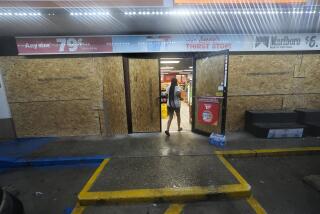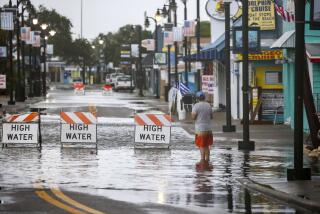Louisiana towns put their faith in sandbags
Reporting from Stephensville, La. — More water gushed from additional floodgates opened Sunday to divert the swollen Mississippi River down a southern Louisiana floodplain, leaving residents of tiny towns in the water’s path a grim choice: leave, or hope that the sandbags, levees and walls protecting them from inundation hold against the worst floods in decades.
Nancy Allen, a spokeswoman for the U.S. Army Corps of Engineers in New Orleans, said two more gates were lifted at the giant Morganza Spillway, some 40 miles north of Baton Rouge, which was put into operation Saturday for the first time since 1973. The spillway has 125 gates, and by Sunday evening four of them had been opened, sending 40,000 cubic feet of water per second rushing toward towns in the Atchafalaya River Basin.
“I’m going to sit here and I’m going to fight it till I can’t fight it no more,” said Glenn Rulf, sitting atop some of the 1,200 sandbags he and his family have piled around their single-story brick home on a leafy street of Stephensville. The town sits a few miles from Morgan City on the shores of Lake Palourd — a particularly vulnerable position. Officials and locals are concerned that the additional water being sent down the Atchafalaya River, which skirts Morgan City, will wash around into the lake and swamp Stephensville.
“We don’t have no levees. We don’t got nothing,” said Rulf’s wife, Mandy, who had packed her most precious items — family photographs, the children’s scrapbooks — into boxes and placed them next to the front door in case a quick evacuation became necessary. When, or if, that might happen, she couldn’t say.
“You hear so much — you hear everything from it’s going to be nothing to it’s going to be up to the roofs like Hurricane Katrina,” she said.
At a meeting last Monday, corps officials told residents: “Prepare for the worst. It’s coming,” Glenn Rulf said.
Many neighbors have already fled, leaving quiet homes ringed by walls of sandbags piled 2 to 3 feet high. Driveways along the street were empty. Along the lone two-lane road leading into Stephensville and skirting the lake, workers were piling up dirt- and sand-filled fortifications in case the lake overflowed. Members of the National Guard had set up a small base at the Stephensville elementary school to help with any evacuations that might become necessary.
About 25,000 people live in the Atchafalaya River Basin, and some have been warned the water could rise as high as 29 feet as a result of the Morganza Spillway’s opening — a move calculated to relieve pressure on the levees protecting Baton Rouge and New Orleans.
In some areas, local officials have issued mandatory evacuation orders. Christina Stephens, a spokeswoman for the Governor’s Office of Homeland Security and Emergency Preparedness, said even without orders, people were pulling out of the area.
“People are taking this very seriously, and they’re packing up and leaving on their own,” said Stephens, who was not aware of any holdouts defying mandatory orders. But, she added, “There’s always that possibility.”
State and local authorities have identified about 100 locations where sand boils, or areas of leakage, have been spotted in local levees, Stephens said. Those areas are being reinforced.
The water wasn’t expected to reach the Morgan City area for at least another two or three days, and residents showed no signs of urgency Sunday as they strolled along the top of the gray sea wall holding back the rising Atchafalaya River.
The “great wall,” as the 22-foot-high structure is dubbed, has never been tested like this. During the last major floods, in 1973, it was only 10 feet high. The wall held then, but locals said they expected the river to be far higher this time.
“It’s scary. Very scary,” Lois Fryou said as she gazed down at the Atchafalaya, sparkling in the late afternoon sun. The wharf was virtually invisible beneath the water, its pedestrian paths swamped and pylons covered, save for a couple feet of wood poking from the river. A “no parking” sign peered out of the water, and trickles of river seeped onto the street beneath massive metal gates leading to the wharf.
“The sea wall is supposed to hold it back,” said Carlo Gagliono of Morgan City with a shrug. “We’ll see.”
Parts of the town of Melville not protected by levees were under a mandatory evacuation order. The shelves inside the gas station — temporarily opened so people could fill up before leaving town — were barren save for some soft drinks and motor oil.
And in Butte La Rose, a hamlet about 50 miles downstream from the Morganza Spillway, Chalmers Wheat was one of the few people still lining his home with plastic and sandbags.
“It’s almost like a ghost town,” said Wheat as he and his brother, Chandler, made final preparations before leaving for higher ground.
The opening of the Morganza was the latest attempt to prevent flooding of major population centers along the Mississippi, which has been swollen by unusually heavy rains and runoff from winter snows.
Earlier this month, the Army Corps of Engineers blew up a levee in Missouri, sending water across farmland and rural areas to protect the city of Cairo, Ill. The corps’ decision to open the Morganza Spillway was based on the same premise: that it was best to intentionally flood sparsely populated areas with a relatively slow, controlled stream of water than risk catastrophic floods by subjecting levees to more than they were built to handle.
Times staff writer David Zucchino contributed to this report, as did the Associated Press.
More to Read
Sign up for Essential California
The most important California stories and recommendations in your inbox every morning.
You may occasionally receive promotional content from the Los Angeles Times.











